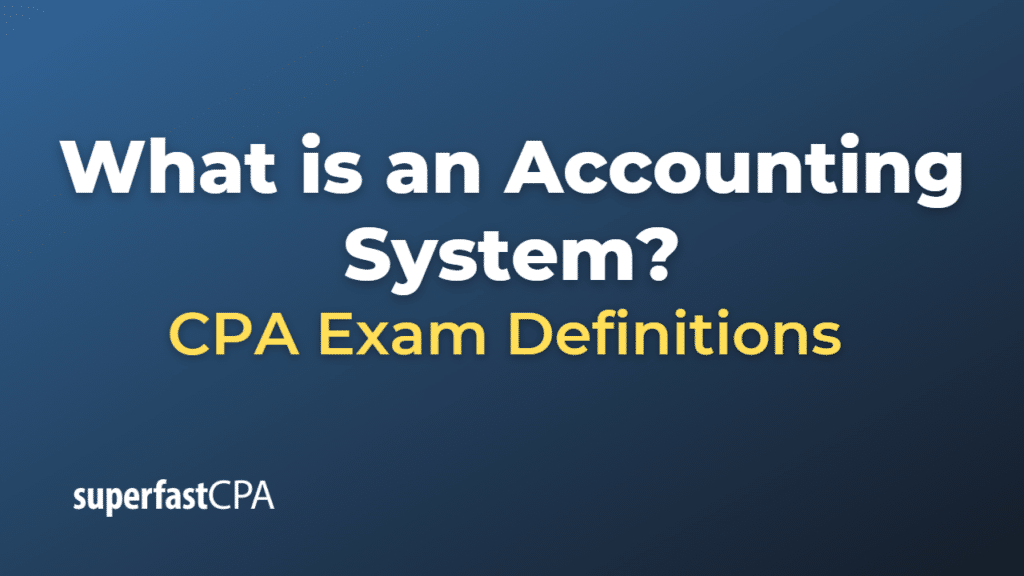Accounting System
An accounting system is a structured set of procedures, processes, and tools used by organizations to record, classify, analyze, and report financial transactions and information. It serves as the backbone of a company’s financial management and reporting, enabling effective decision-making and compliance with regulatory requirements. An accounting system helps businesses track their financial performance, manage cash flow, monitor expenses and revenues, and maintain accurate financial records.
Accounting systems can be manual or computerized, and they typically include the following components:
- Chart of accounts: A comprehensive list of all the accounts used by an organization to classify and record financial transactions. It provides a framework for organizing financial data and serves as the basis for preparing financial statements.
- Journals: Records where financial transactions are initially recorded in chronological order. These include the general journal, where non-routine transactions are recorded, and special journals, which are used for recording routine transactions, such as sales, purchases, cash receipts, and cash disbursements.
- Ledgers: A set of individual accounts where financial transactions are summarized and classified. The general ledger contains all the accounts needed to prepare financial statements, while subsidiary ledgers provide detailed information about specific types of transactions, such as accounts receivable or accounts payable.
- Trial balance: A report that lists all the accounts and their balances at a specific point in time. It helps in verifying the accuracy of the accounting records and detecting errors before preparing financial statements.
- Financial statements: The primary output of an accounting system, which includes the income statement, balance sheet, statement of cash flows, and statement of changes in equity. These statements provide a summary of a company’s financial performance and position over a specific period.
- Internal controls: Policies and procedures designed to safeguard the organization’s assets, ensure the reliability of financial information, and promote compliance with laws and regulations.
Modern accounting systems are often computerized, using specialized accounting software or enterprise resource planning (ERP) systems to automate and streamline the recording, processing, and reporting of financial transactions. These systems can provide real-time access to financial data, support complex business processes, and generate a wide range of financial reports and analysis.
Selecting and implementing an appropriate accounting system is crucial for businesses of all sizes, as it helps maintain accurate financial records, supports effective decision-making, and ensures compliance with tax and regulatory requirements.
Example of an Accounting System
Let’s consider a fictional small business, “Bella’s Bakery,” which needs an accounting system to manage its financial transactions and reporting. In this example, we will outline the key components of Bella’s Bakery’s accounting system:
- Chart of accounts: Bella’s Bakery will have a chart of accounts that includes categories such as assets, liabilities, equity, revenues, and expenses. Under these categories, there will be specific accounts, such as cash, accounts receivable, inventory, accounts payable, sales revenue, and various expense accounts (e.g., rent expense, utility expense, and wages expense).
- Journals: The bakery will record all financial transactions in journals. For example, when Bella’s Bakery sells baked goods, the transaction will be recorded in the sales journal. When the bakery purchases ingredients from a supplier, the transaction will be recorded in the purchases journal.
- Ledgers: Bella’s Bakery will maintain a general ledger that summarizes all its financial transactions. Additionally, it may use subsidiary ledgers for specific accounts, such as accounts receivable or accounts payable, to track details of individual customers or suppliers.
- Trial balance: Periodically, Bella’s Bakery will prepare a trial balance to ensure the total debits equal the total credits for all accounts. This step helps identify any errors or discrepancies in the accounting records before preparing the financial statements.
- Financial statements: Bella’s Bakery will generate financial statements, including an income statement (showing the bakery’s revenues and expenses), a balance sheet (providing a snapshot of the bakery’s assets, liabilities, and equity), and a statement of cash flows (detailing the bakery’s cash inflows and outflows).
- Internal controls: Bella’s Bakery will implement internal controls to safeguard its assets, ensure the accuracy of its financial records, and comply with tax and regulatory requirements. These controls may include separation of duties, regular inventory counts, and periodic bank reconciliations.
In this example, Bella’s Bakery may start with a manual accounting system using spreadsheets or physical ledgers. However, as the business grows, it may choose to implement a computerized accounting system using software like QuickBooks, Xero, or an ERP system. This transition can help streamline processes, improve accuracy, and provide real-time access to financial data, enhancing the overall effectiveness of the accounting system.













